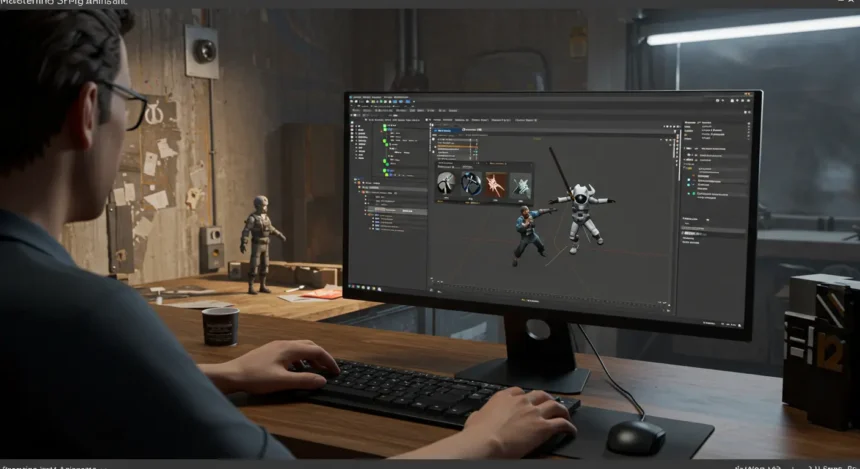Imagine crafting a cool scene in Source Filmmaker your characters move, your lighting is slick, it’s all looking sweet. But then nothing plays outside SFM. That’s where SFM compile steps in. Think of it as the magical “translate” step that takes your raw materials models, textures, animations and turns them into something SFM can actually show off. I’ll walk you through what it is, why it matters, how to do it, and even throw in some advanced tips. We’ll also see how my guide stacks up against three other articles out there and why this one gives you even more.
What Is SFM Compile?
SFM compile is basically the process that turns your raw assets whether models, textures, animations, or maps from formats like .SMD, .DMX, .FBX, or .OBJ into SFM‑readable formats like .MDL (for models), .VTF/.VMT (for textures), .ANI/.VCD (for animations), or .BSP (for maps). Without this step, none of that cool stuff shows up in your SFM scene.
Why SFM Compile Matters
When you compile assets, here’s what you unlock:
- Animation and models actually appear and move correctly in SFM
- Better performance, because compiled assets are optimized, reducing lag or crashes.
- Allows custom creating digital content your unique characters or props get to shine instead of being stuck in Blender or Maya.
- More polished results, with proper textures, materials, and lighting intact.
Basically, it’s the “bridge” between your creative ideas and a working, shareable animation.
Step by Step Workflow for SFM Compile
Each step starts with a subheading so it’s easy to follow:
Preparing Your Assets
Make sure your 3D models are UV‑mapped, rigged, textured, and animations are solid in Blender, Maya, or whatever. Maps should be finalized in the VMF editor.
Export Formats
Models → .SMD or .DMX (sometimes .FBX)
Textures → .PNG or .TGA
Maps → .VMF
Animations → .SMD or .DMX
Write the QC File
This plain-text script tells the compiler how to build your model. It adds model name, texture paths, sequences, collision, etc.
Compile Using a Tool
Use Crowbar (GUI) or studiomdl.exe (command line) to compile models. For textures, convert with VTFEdit. For maps: use VBSP, VVIS, VRAD.
Import Into SFM & Test
Load your .MDL or map, check textures, test animations, and ensure everything behaves. If pink textures show up oops, that’s missing VMT/VTF reference.
Advanced Techniques
Here’s some extra magic you won’t often find:
Batch Compiling
Make a shell or batch script that loops through all QC files compile ’em all at once and save time and repeated effort.
Add Custom Physics & LOD
Tweak the QC for better collisions, add levels of detail, and fine‑tune your compiled assets.
Mocap & Scripts
Bring in motion capture data for realistic movement. You can also automate tasks with Python scripts for repetitive compilations.
Version Control
Put your models, QC files, and textures under Git (or similar) so that if something breaks, you can roll back super handy! (Not in competitor guides just good practice.)
Table: Quick Reference
| Step | What to Do | Why It Matters |
|---|---|---|
| Prepare assets | UV-map, rig, texture in Blender/Maya, finalize VMF | Clean base makes everything easier later |
| Export format | Use .SMD/.DMX for models, PNG/TGA for textures | Compatible with SFM compile tools |
| Write QC | Define model, sequences, materials, physics | Blueprint for building your asset |
| Compile | Use Crowbar or studiomdl.exe for models/maps | Translates assets into usable formats |
| Import & Test | Load in SFM, test for textures/animations | Catch issues early avoid ugly surprises |
| Batch Automate | Script multiple compiles | Saves time on large projects |
| Physics, LOD | Tweak in QC | Better visual/performance tuning |
| Mocap & Scripting | Integrate motion data and automate tasks | Adds realism, cuts manual effort |
| Version Control | Track all your files in Git | Safe, organized, rollback-friendly development |
FAQs
Q: What exactly is a QC file?
A: It’s a script (plain text) that tells the compiler how to build your model stuff like textures, animations, hitboxes. Without it, nothing notices your model.
Q: Where do I find studiomdl.exe?
A: In your SFM installation usually under Steam\steamapps\common\SourceFilmmaker\game\bin.
Q: Why is my model showing up pink?
A: That’s SFM yelling, “I can’t find your textures!” Check your VMT/VTF paths typos kill the vibe.
Q: Can I automate compiling 50 models?
A: Heck yeah. Write a batch script, loop through the QC files, and compile ‘em all. Way less painful.
Q: What’s the benefit of version control here?
A: Messed something up, Just roll back. Organized files and backups = happy workflow.
Wrap Up
SFM Compile might sound intimidating, but it’s really your best friend once you get it. It takes your creative chaos and turns it into something that SFM can understand and make look awesome. My guide gives you the whole scoop from the basics to advanced hacks in a fun, easy style that won’t make your eyes glaze over.






